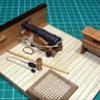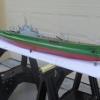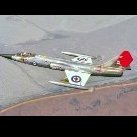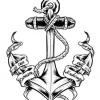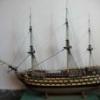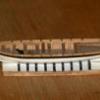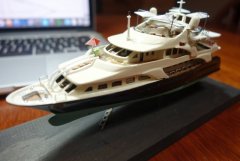Supplies of the Ship Modeler's Handbook are running out. Get your copy NOW before they are gone! Click on photo to order.
×
-
Posts
5,869 -
Joined
-
Last visited
Reputation Activity
-
 BANYAN got a reaction from Canute in Michael Mott Designed Third Hand
BANYAN got a reaction from Canute in Michael Mott Designed Third Hand
Hi again folks,
To say I am impressed with Michael's third hand tool is a gross understatement - the versatility of this third hand with interchangeable clamps makes working with rigging and small metal parts a breeze. Before proceeding, I must state that I have no financial or pecuniary involvement with Michal and offer the following for the benefit of MSW members. I must also declare that Michael has provided several clamps for me to trial and comment on, but I have purchased the third arm and initial set of clamps at the advised price.
I have received some additional clamps from Michael today. I have completed some very quick tests and offer the following initial comments; I will provide further feedback after further use of them over the next few days. Within my feedback I will also include comments on the build and test materials, the sizes and locations of the tightening screws, and on the types of clamps and modification to them. I hope to also complete a comparative test on soldering various items with the clamps in Michael's design against the GRS soldering station.
The tool itself, and the clamps are all very well made with only quality materials used. Using it, you get the 'feel' that this is a quality tool and gain some confidence the tool is not going to wear out or break like some of those cheap third hands. The only small problem might be that some of the springs may need to be replaced later in a clamp's life (depending on usage and clamping pressures used). I opted for the rectangular base which has proven very useful. The weight is just right for stability and the aluminium is strong but light, reducing postage costs; and the shape also lends to easy clamping of the base to the bench for additional stability.
First up I will address the tool itself. The design at this point has met tasks I have tried. The height of the cross bar is low enough to create good stability, but high enough to get under and around anything I have tried clamping. The height of the arms seems sufficient for the task also with enough room for wrapping seizing around the object without getting caught up in the arms or having to poke the stock through. The length of the main crossbar is of a good length, and if more is required, this design would allow easy replacement.
The functionality/flexibility of the tool is very good with an extensive range of positioning and clamping options to suit the task (and Michael is working on additional clamp options). I found it much easier to position the arms on Michael's third hand, for most jobs, than with any of the other versions I have, including the GRS Workstation mentioned/shown in my first post. The arms can be positioned in almost any position required without the minute tweaking required from the ball and pressure plate with wingnut type joints. I find tweaking the GRS problematic for those minute adjustments to get the position of the parts to be soldered 'just right' - I found the thumbwheel control on rotating joints so much easier with this design by just slackening off a tiny bit of the pressure while adjusting.
Once the arms have been positioned, the clamps themselves can be readjusted quite easily if required, and just the right amount of pressure can be applied using the thumbscrew, rather than a one pressure suits all approach using the spring clamp options or alligator clips. The increasing range of clamp styles will also allow selection of a 'fit-for-purpose' clamp for the job. While I could not achieve the same direct angling of the arms in some positions (as with the GRS - see photo for difference), the design of the clamps still allows me to get the required angle. A possible design tweak might be to provide an articulated elbow in the vertical riser arms; however, the more complexity added the greater the risk of something slipping?
That said, applying the right amount of pressure with thumbwheels on some of the rotating joints takes some exertion occasionally. I believe Michael is aware of this issue and thinking of replacing some of these tightening screws with the ball lever style.
My collection of clamps (Happy Days)
I have now tried several clamp options which I will comment on in the next post.
As always, comments and feedback are most welcomed.
Cheers
Pat
-
 BANYAN got a reaction from popeye the sailor in IJN Yamato by RGL - FINISHED - Tamiya - 1/350 - PLASTIC
BANYAN got a reaction from popeye the sailor in IJN Yamato by RGL - FINISHED - Tamiya - 1/350 - PLASTIC
That is stunning Greg, really good work with the airbrush. Weathering; looks like you have started - there appears to be some nice grime effect in the gun tubs at least. and the looks of some rust on the leading oblique plates of the rangefinder extensions?
cheers
Pat
-
 BANYAN got a reaction from Piet in IJN Musashi by cog - Tamiya - 1:350 - PLASTIC - old tool
BANYAN got a reaction from Piet in IJN Musashi by cog - Tamiya - 1:350 - PLASTIC - old tool
Nice work Carl; that bling is adding some nice detail. Could always drape a thick chunky gold chain around it also
cheers
Pat
-
 BANYAN got a reaction from Mike Y in Michael Mott Designed Third Hand
BANYAN got a reaction from Mike Y in Michael Mott Designed Third Hand
Hi again folks, as promised some initial thoughts on some of the clamps Michael is developing for the third arm. The flexibility of having clamp options is one of the greatest assets of this design as you can select the clamp best suited to the task at hand.
I will explain each clamp style/type with photos (as required) and accompanying text. For the initial testing, I used some PE flat strips, some hard wire brass eyes, soft copper wire eyes and offcut wood (soft and hard) - note to oneself, don't over pressure when clamping softer woods
First up is the toolmaker style. I find this one very useful for many tasks both metal and wood as even with hard edges to the metal of the clamp, the parallel action allows an even clamping pressure. It is the best overall design for soldering tasks. Further flexibility can be achieved with the use of sacrificial wood/plastic jaw inserts for non-soldering tasks if marking of the material is a concern. however, the parallel action of these jaws minimises this risk and I have successfully held all materials mentioned above in the jaws with sufficient pressure that it would not move in the jaw, and without marking the materials.
Second, the two metal finger style clamps. I found the one, with the O ring, the most versatile as it opens wider and applies sufficient pressure to hold most things; but I don't know how that O ring might cope when using it to solder things - the mechanism copes well and seems better/easier to control the pressure than the other type, and provided better clamping effect/pressure overall than the type 2. It held the wire eyes easily and did not crush/marr the copper one. I did not try wood in these as I do not see a purpose for doing so.
The second of the finger types is better in principle for soldering (no parts to melt), but does not open as much and I found that it did not grip the flat PE very well as I think the gripping pressure is only applied at the tip of the clamp (the PE strip shown in the photos rotated very easily even with extra tension on the thumbscrew).
Which of these would I use? I prefer the O ring style (type 1) for function and gripping, but I am worried about using an O ring which would probably melt/deteriorate with heat during soldering? Michael has explained that it is really not designed for soldering and the toolmakers style clamp is the better option.
Now for the wood style Clamps. These are designed primarily for rigging/use with soft materials. Again, these function beautifully and I can see a lot of use being made of this pair . These are constructed from boxwood which provides a soft mouth (jaws) but retains sufficient density that they will not wear too quickly. Michael provided this pair with two grooves made by crushing a needle of the required size (to suit the scale rope) between the jaws. the user can do this to suit the tasks and other sizes of rope, but may need a additional clamps.
That said, for one of the tasks I had in mind I prefer to run the rope between two clamps longitudinally (see out of focus photo - sorry) when doing some rigging tasks. This is where I still think a collet style clamp may be more flexible, but have yet to be convinced, as you would not want to have a myriad of crossing grooves in the wood jaws for different sized threads and directions of holding them. I have yet to try wire rope as I have not made any up yet. I am also concerned that wire rope would mar the jaws of the wooden ones, and that the metal jaws would crush the wire strands out of shape permanently? All to be investigated/tested later.
A couple of ideas I am investigating which may assist in rigging blocks, soft or hard eyes in rope etc. A rod, of the same size as the other clamps, with a 90 degree thin hardened wire bend soldered on the end, upon which you can slip a made eye, a block etc to assist with rigging? The photo below shows the concept. Another way of achieving the same functionality, and much easier for the user to do themselves, would be to put a pin (old micro-drill shank of appropriate shank sizes) in the top of the wood clamps. See the second photo of simulated pin in wood clamp concept.
That is all for today, I hope you all find this feedback useful.
cheers
Pat
-
 BANYAN got a reaction from WackoWolf in Michael Mott Designed Third Hand
BANYAN got a reaction from WackoWolf in Michael Mott Designed Third Hand
Hi again folks,
To say I am impressed with Michael's third hand tool is a gross understatement - the versatility of this third hand with interchangeable clamps makes working with rigging and small metal parts a breeze. Before proceeding, I must state that I have no financial or pecuniary involvement with Michal and offer the following for the benefit of MSW members. I must also declare that Michael has provided several clamps for me to trial and comment on, but I have purchased the third arm and initial set of clamps at the advised price.
I have received some additional clamps from Michael today. I have completed some very quick tests and offer the following initial comments; I will provide further feedback after further use of them over the next few days. Within my feedback I will also include comments on the build and test materials, the sizes and locations of the tightening screws, and on the types of clamps and modification to them. I hope to also complete a comparative test on soldering various items with the clamps in Michael's design against the GRS soldering station.
The tool itself, and the clamps are all very well made with only quality materials used. Using it, you get the 'feel' that this is a quality tool and gain some confidence the tool is not going to wear out or break like some of those cheap third hands. The only small problem might be that some of the springs may need to be replaced later in a clamp's life (depending on usage and clamping pressures used). I opted for the rectangular base which has proven very useful. The weight is just right for stability and the aluminium is strong but light, reducing postage costs; and the shape also lends to easy clamping of the base to the bench for additional stability.
First up I will address the tool itself. The design at this point has met tasks I have tried. The height of the cross bar is low enough to create good stability, but high enough to get under and around anything I have tried clamping. The height of the arms seems sufficient for the task also with enough room for wrapping seizing around the object without getting caught up in the arms or having to poke the stock through. The length of the main crossbar is of a good length, and if more is required, this design would allow easy replacement.
The functionality/flexibility of the tool is very good with an extensive range of positioning and clamping options to suit the task (and Michael is working on additional clamp options). I found it much easier to position the arms on Michael's third hand, for most jobs, than with any of the other versions I have, including the GRS Workstation mentioned/shown in my first post. The arms can be positioned in almost any position required without the minute tweaking required from the ball and pressure plate with wingnut type joints. I find tweaking the GRS problematic for those minute adjustments to get the position of the parts to be soldered 'just right' - I found the thumbwheel control on rotating joints so much easier with this design by just slackening off a tiny bit of the pressure while adjusting.
Once the arms have been positioned, the clamps themselves can be readjusted quite easily if required, and just the right amount of pressure can be applied using the thumbscrew, rather than a one pressure suits all approach using the spring clamp options or alligator clips. The increasing range of clamp styles will also allow selection of a 'fit-for-purpose' clamp for the job. While I could not achieve the same direct angling of the arms in some positions (as with the GRS - see photo for difference), the design of the clamps still allows me to get the required angle. A possible design tweak might be to provide an articulated elbow in the vertical riser arms; however, the more complexity added the greater the risk of something slipping?
That said, applying the right amount of pressure with thumbwheels on some of the rotating joints takes some exertion occasionally. I believe Michael is aware of this issue and thinking of replacing some of these tightening screws with the ball lever style.
My collection of clamps (Happy Days)
I have now tried several clamp options which I will comment on in the next post.
As always, comments and feedback are most welcomed.
Cheers
Pat
-
 BANYAN got a reaction from popeye the sailor in IJN Musashi by cog - Tamiya - 1:350 - PLASTIC - old tool
BANYAN got a reaction from popeye the sailor in IJN Musashi by cog - Tamiya - 1:350 - PLASTIC - old tool
Nice work Carl; that bling is adding some nice detail. Could always drape a thick chunky gold chain around it also
cheers
Pat
-
 BANYAN got a reaction from popeye the sailor in IJN Yamato by RGL - FINISHED - Tamiya - 1/350 - PLASTIC
BANYAN got a reaction from popeye the sailor in IJN Yamato by RGL - FINISHED - Tamiya - 1/350 - PLASTIC
You're getting quite the dab hand at this Greg; those gun turrets look very good indeed. Nice work.
cheers
Pat
-
 BANYAN got a reaction from Canute in IJN Musashi by cog - Tamiya - 1:350 - PLASTIC - old tool
BANYAN got a reaction from Canute in IJN Musashi by cog - Tamiya - 1:350 - PLASTIC - old tool
Nice work Carl; that bling is adding some nice detail. Could always drape a thick chunky gold chain around it also
cheers
Pat
-
 BANYAN reacted to cog in IJN Musashi by cog - Tamiya - 1:350 - PLASTIC - old tool
BANYAN reacted to cog in IJN Musashi by cog - Tamiya - 1:350 - PLASTIC - old tool
Components of the covered AA gun, and replacement parts
Some careful treading on the funnel. Had a hard time getting those brass thready thingies on ...
Before with some more bling bling on the forward tower, and two additional gun directors (they had some gun directors and rangefinders installed on these ships!!)
and after
-
 BANYAN got a reaction from wefalck in Michael Mott Designed Third Hand
BANYAN got a reaction from wefalck in Michael Mott Designed Third Hand
Hi again folks, as promised some initial thoughts on some of the clamps Michael is developing for the third arm. The flexibility of having clamp options is one of the greatest assets of this design as you can select the clamp best suited to the task at hand.
I will explain each clamp style/type with photos (as required) and accompanying text. For the initial testing, I used some PE flat strips, some hard wire brass eyes, soft copper wire eyes and offcut wood (soft and hard) - note to oneself, don't over pressure when clamping softer woods
First up is the toolmaker style. I find this one very useful for many tasks both metal and wood as even with hard edges to the metal of the clamp, the parallel action allows an even clamping pressure. It is the best overall design for soldering tasks. Further flexibility can be achieved with the use of sacrificial wood/plastic jaw inserts for non-soldering tasks if marking of the material is a concern. however, the parallel action of these jaws minimises this risk and I have successfully held all materials mentioned above in the jaws with sufficient pressure that it would not move in the jaw, and without marking the materials.
Second, the two metal finger style clamps. I found the one, with the O ring, the most versatile as it opens wider and applies sufficient pressure to hold most things; but I don't know how that O ring might cope when using it to solder things - the mechanism copes well and seems better/easier to control the pressure than the other type, and provided better clamping effect/pressure overall than the type 2. It held the wire eyes easily and did not crush/marr the copper one. I did not try wood in these as I do not see a purpose for doing so.
The second of the finger types is better in principle for soldering (no parts to melt), but does not open as much and I found that it did not grip the flat PE very well as I think the gripping pressure is only applied at the tip of the clamp (the PE strip shown in the photos rotated very easily even with extra tension on the thumbscrew).
Which of these would I use? I prefer the O ring style (type 1) for function and gripping, but I am worried about using an O ring which would probably melt/deteriorate with heat during soldering? Michael has explained that it is really not designed for soldering and the toolmakers style clamp is the better option.
Now for the wood style Clamps. These are designed primarily for rigging/use with soft materials. Again, these function beautifully and I can see a lot of use being made of this pair . These are constructed from boxwood which provides a soft mouth (jaws) but retains sufficient density that they will not wear too quickly. Michael provided this pair with two grooves made by crushing a needle of the required size (to suit the scale rope) between the jaws. the user can do this to suit the tasks and other sizes of rope, but may need a additional clamps.
That said, for one of the tasks I had in mind I prefer to run the rope between two clamps longitudinally (see out of focus photo - sorry) when doing some rigging tasks. This is where I still think a collet style clamp may be more flexible, but have yet to be convinced, as you would not want to have a myriad of crossing grooves in the wood jaws for different sized threads and directions of holding them. I have yet to try wire rope as I have not made any up yet. I am also concerned that wire rope would mar the jaws of the wooden ones, and that the metal jaws would crush the wire strands out of shape permanently? All to be investigated/tested later.
A couple of ideas I am investigating which may assist in rigging blocks, soft or hard eyes in rope etc. A rod, of the same size as the other clamps, with a 90 degree thin hardened wire bend soldered on the end, upon which you can slip a made eye, a block etc to assist with rigging? The photo below shows the concept. Another way of achieving the same functionality, and much easier for the user to do themselves, would be to put a pin (old micro-drill shank of appropriate shank sizes) in the top of the wood clamps. See the second photo of simulated pin in wood clamp concept.
That is all for today, I hope you all find this feedback useful.
cheers
Pat
-
 BANYAN got a reaction from Haliburton in Michael Mott Designed Third Hand
BANYAN got a reaction from Haliburton in Michael Mott Designed Third Hand
Hi again folks,
To say I am impressed with Michael's third hand tool is a gross understatement - the versatility of this third hand with interchangeable clamps makes working with rigging and small metal parts a breeze. Before proceeding, I must state that I have no financial or pecuniary involvement with Michal and offer the following for the benefit of MSW members. I must also declare that Michael has provided several clamps for me to trial and comment on, but I have purchased the third arm and initial set of clamps at the advised price.
I have received some additional clamps from Michael today. I have completed some very quick tests and offer the following initial comments; I will provide further feedback after further use of them over the next few days. Within my feedback I will also include comments on the build and test materials, the sizes and locations of the tightening screws, and on the types of clamps and modification to them. I hope to also complete a comparative test on soldering various items with the clamps in Michael's design against the GRS soldering station.
The tool itself, and the clamps are all very well made with only quality materials used. Using it, you get the 'feel' that this is a quality tool and gain some confidence the tool is not going to wear out or break like some of those cheap third hands. The only small problem might be that some of the springs may need to be replaced later in a clamp's life (depending on usage and clamping pressures used). I opted for the rectangular base which has proven very useful. The weight is just right for stability and the aluminium is strong but light, reducing postage costs; and the shape also lends to easy clamping of the base to the bench for additional stability.
First up I will address the tool itself. The design at this point has met tasks I have tried. The height of the cross bar is low enough to create good stability, but high enough to get under and around anything I have tried clamping. The height of the arms seems sufficient for the task also with enough room for wrapping seizing around the object without getting caught up in the arms or having to poke the stock through. The length of the main crossbar is of a good length, and if more is required, this design would allow easy replacement.
The functionality/flexibility of the tool is very good with an extensive range of positioning and clamping options to suit the task (and Michael is working on additional clamp options). I found it much easier to position the arms on Michael's third hand, for most jobs, than with any of the other versions I have, including the GRS Workstation mentioned/shown in my first post. The arms can be positioned in almost any position required without the minute tweaking required from the ball and pressure plate with wingnut type joints. I find tweaking the GRS problematic for those minute adjustments to get the position of the parts to be soldered 'just right' - I found the thumbwheel control on rotating joints so much easier with this design by just slackening off a tiny bit of the pressure while adjusting.
Once the arms have been positioned, the clamps themselves can be readjusted quite easily if required, and just the right amount of pressure can be applied using the thumbscrew, rather than a one pressure suits all approach using the spring clamp options or alligator clips. The increasing range of clamp styles will also allow selection of a 'fit-for-purpose' clamp for the job. While I could not achieve the same direct angling of the arms in some positions (as with the GRS - see photo for difference), the design of the clamps still allows me to get the required angle. A possible design tweak might be to provide an articulated elbow in the vertical riser arms; however, the more complexity added the greater the risk of something slipping?
That said, applying the right amount of pressure with thumbwheels on some of the rotating joints takes some exertion occasionally. I believe Michael is aware of this issue and thinking of replacing some of these tightening screws with the ball lever style.
My collection of clamps (Happy Days)
I have now tried several clamp options which I will comment on in the next post.
As always, comments and feedback are most welcomed.
Cheers
Pat
-
 BANYAN got a reaction from Pierretessier in Michael Mott Designed Third Hand
BANYAN got a reaction from Pierretessier in Michael Mott Designed Third Hand
Hi again folks, as promised some initial thoughts on some of the clamps Michael is developing for the third arm. The flexibility of having clamp options is one of the greatest assets of this design as you can select the clamp best suited to the task at hand.
I will explain each clamp style/type with photos (as required) and accompanying text. For the initial testing, I used some PE flat strips, some hard wire brass eyes, soft copper wire eyes and offcut wood (soft and hard) - note to oneself, don't over pressure when clamping softer woods
First up is the toolmaker style. I find this one very useful for many tasks both metal and wood as even with hard edges to the metal of the clamp, the parallel action allows an even clamping pressure. It is the best overall design for soldering tasks. Further flexibility can be achieved with the use of sacrificial wood/plastic jaw inserts for non-soldering tasks if marking of the material is a concern. however, the parallel action of these jaws minimises this risk and I have successfully held all materials mentioned above in the jaws with sufficient pressure that it would not move in the jaw, and without marking the materials.
Second, the two metal finger style clamps. I found the one, with the O ring, the most versatile as it opens wider and applies sufficient pressure to hold most things; but I don't know how that O ring might cope when using it to solder things - the mechanism copes well and seems better/easier to control the pressure than the other type, and provided better clamping effect/pressure overall than the type 2. It held the wire eyes easily and did not crush/marr the copper one. I did not try wood in these as I do not see a purpose for doing so.
The second of the finger types is better in principle for soldering (no parts to melt), but does not open as much and I found that it did not grip the flat PE very well as I think the gripping pressure is only applied at the tip of the clamp (the PE strip shown in the photos rotated very easily even with extra tension on the thumbscrew).
Which of these would I use? I prefer the O ring style (type 1) for function and gripping, but I am worried about using an O ring which would probably melt/deteriorate with heat during soldering? Michael has explained that it is really not designed for soldering and the toolmakers style clamp is the better option.
Now for the wood style Clamps. These are designed primarily for rigging/use with soft materials. Again, these function beautifully and I can see a lot of use being made of this pair . These are constructed from boxwood which provides a soft mouth (jaws) but retains sufficient density that they will not wear too quickly. Michael provided this pair with two grooves made by crushing a needle of the required size (to suit the scale rope) between the jaws. the user can do this to suit the tasks and other sizes of rope, but may need a additional clamps.
That said, for one of the tasks I had in mind I prefer to run the rope between two clamps longitudinally (see out of focus photo - sorry) when doing some rigging tasks. This is where I still think a collet style clamp may be more flexible, but have yet to be convinced, as you would not want to have a myriad of crossing grooves in the wood jaws for different sized threads and directions of holding them. I have yet to try wire rope as I have not made any up yet. I am also concerned that wire rope would mar the jaws of the wooden ones, and that the metal jaws would crush the wire strands out of shape permanently? All to be investigated/tested later.
A couple of ideas I am investigating which may assist in rigging blocks, soft or hard eyes in rope etc. A rod, of the same size as the other clamps, with a 90 degree thin hardened wire bend soldered on the end, upon which you can slip a made eye, a block etc to assist with rigging? The photo below shows the concept. Another way of achieving the same functionality, and much easier for the user to do themselves, would be to put a pin (old micro-drill shank of appropriate shank sizes) in the top of the wood clamps. See the second photo of simulated pin in wood clamp concept.
That is all for today, I hope you all find this feedback useful.
cheers
Pat
-
 BANYAN reacted to RGL in IJN Yamato by RGL - FINISHED - Tamiya - 1/350 - PLASTIC
BANYAN reacted to RGL in IJN Yamato by RGL - FINISHED - Tamiya - 1/350 - PLASTIC
A little more work on the main guns, the blast bags completed and painted, the gun tubs added and the first wash applied to bring out detail before weathering.
-
 BANYAN got a reaction from Bill Tuttle in Michael Mott Designed Third Hand
BANYAN got a reaction from Bill Tuttle in Michael Mott Designed Third Hand
Hi again folks, as promised some initial thoughts on some of the clamps Michael is developing for the third arm. The flexibility of having clamp options is one of the greatest assets of this design as you can select the clamp best suited to the task at hand.
I will explain each clamp style/type with photos (as required) and accompanying text. For the initial testing, I used some PE flat strips, some hard wire brass eyes, soft copper wire eyes and offcut wood (soft and hard) - note to oneself, don't over pressure when clamping softer woods
First up is the toolmaker style. I find this one very useful for many tasks both metal and wood as even with hard edges to the metal of the clamp, the parallel action allows an even clamping pressure. It is the best overall design for soldering tasks. Further flexibility can be achieved with the use of sacrificial wood/plastic jaw inserts for non-soldering tasks if marking of the material is a concern. however, the parallel action of these jaws minimises this risk and I have successfully held all materials mentioned above in the jaws with sufficient pressure that it would not move in the jaw, and without marking the materials.
Second, the two metal finger style clamps. I found the one, with the O ring, the most versatile as it opens wider and applies sufficient pressure to hold most things; but I don't know how that O ring might cope when using it to solder things - the mechanism copes well and seems better/easier to control the pressure than the other type, and provided better clamping effect/pressure overall than the type 2. It held the wire eyes easily and did not crush/marr the copper one. I did not try wood in these as I do not see a purpose for doing so.
The second of the finger types is better in principle for soldering (no parts to melt), but does not open as much and I found that it did not grip the flat PE very well as I think the gripping pressure is only applied at the tip of the clamp (the PE strip shown in the photos rotated very easily even with extra tension on the thumbscrew).
Which of these would I use? I prefer the O ring style (type 1) for function and gripping, but I am worried about using an O ring which would probably melt/deteriorate with heat during soldering? Michael has explained that it is really not designed for soldering and the toolmakers style clamp is the better option.
Now for the wood style Clamps. These are designed primarily for rigging/use with soft materials. Again, these function beautifully and I can see a lot of use being made of this pair . These are constructed from boxwood which provides a soft mouth (jaws) but retains sufficient density that they will not wear too quickly. Michael provided this pair with two grooves made by crushing a needle of the required size (to suit the scale rope) between the jaws. the user can do this to suit the tasks and other sizes of rope, but may need a additional clamps.
That said, for one of the tasks I had in mind I prefer to run the rope between two clamps longitudinally (see out of focus photo - sorry) when doing some rigging tasks. This is where I still think a collet style clamp may be more flexible, but have yet to be convinced, as you would not want to have a myriad of crossing grooves in the wood jaws for different sized threads and directions of holding them. I have yet to try wire rope as I have not made any up yet. I am also concerned that wire rope would mar the jaws of the wooden ones, and that the metal jaws would crush the wire strands out of shape permanently? All to be investigated/tested later.
A couple of ideas I am investigating which may assist in rigging blocks, soft or hard eyes in rope etc. A rod, of the same size as the other clamps, with a 90 degree thin hardened wire bend soldered on the end, upon which you can slip a made eye, a block etc to assist with rigging? The photo below shows the concept. Another way of achieving the same functionality, and much easier for the user to do themselves, would be to put a pin (old micro-drill shank of appropriate shank sizes) in the top of the wood clamps. See the second photo of simulated pin in wood clamp concept.
That is all for today, I hope you all find this feedback useful.
cheers
Pat
-
 BANYAN got a reaction from hexnut in Michael Mott Designed Third Hand
BANYAN got a reaction from hexnut in Michael Mott Designed Third Hand
Hi again folks, as promised some initial thoughts on some of the clamps Michael is developing for the third arm. The flexibility of having clamp options is one of the greatest assets of this design as you can select the clamp best suited to the task at hand.
I will explain each clamp style/type with photos (as required) and accompanying text. For the initial testing, I used some PE flat strips, some hard wire brass eyes, soft copper wire eyes and offcut wood (soft and hard) - note to oneself, don't over pressure when clamping softer woods
First up is the toolmaker style. I find this one very useful for many tasks both metal and wood as even with hard edges to the metal of the clamp, the parallel action allows an even clamping pressure. It is the best overall design for soldering tasks. Further flexibility can be achieved with the use of sacrificial wood/plastic jaw inserts for non-soldering tasks if marking of the material is a concern. however, the parallel action of these jaws minimises this risk and I have successfully held all materials mentioned above in the jaws with sufficient pressure that it would not move in the jaw, and without marking the materials.
Second, the two metal finger style clamps. I found the one, with the O ring, the most versatile as it opens wider and applies sufficient pressure to hold most things; but I don't know how that O ring might cope when using it to solder things - the mechanism copes well and seems better/easier to control the pressure than the other type, and provided better clamping effect/pressure overall than the type 2. It held the wire eyes easily and did not crush/marr the copper one. I did not try wood in these as I do not see a purpose for doing so.
The second of the finger types is better in principle for soldering (no parts to melt), but does not open as much and I found that it did not grip the flat PE very well as I think the gripping pressure is only applied at the tip of the clamp (the PE strip shown in the photos rotated very easily even with extra tension on the thumbscrew).
Which of these would I use? I prefer the O ring style (type 1) for function and gripping, but I am worried about using an O ring which would probably melt/deteriorate with heat during soldering? Michael has explained that it is really not designed for soldering and the toolmakers style clamp is the better option.
Now for the wood style Clamps. These are designed primarily for rigging/use with soft materials. Again, these function beautifully and I can see a lot of use being made of this pair . These are constructed from boxwood which provides a soft mouth (jaws) but retains sufficient density that they will not wear too quickly. Michael provided this pair with two grooves made by crushing a needle of the required size (to suit the scale rope) between the jaws. the user can do this to suit the tasks and other sizes of rope, but may need a additional clamps.
That said, for one of the tasks I had in mind I prefer to run the rope between two clamps longitudinally (see out of focus photo - sorry) when doing some rigging tasks. This is where I still think a collet style clamp may be more flexible, but have yet to be convinced, as you would not want to have a myriad of crossing grooves in the wood jaws for different sized threads and directions of holding them. I have yet to try wire rope as I have not made any up yet. I am also concerned that wire rope would mar the jaws of the wooden ones, and that the metal jaws would crush the wire strands out of shape permanently? All to be investigated/tested later.
A couple of ideas I am investigating which may assist in rigging blocks, soft or hard eyes in rope etc. A rod, of the same size as the other clamps, with a 90 degree thin hardened wire bend soldered on the end, upon which you can slip a made eye, a block etc to assist with rigging? The photo below shows the concept. Another way of achieving the same functionality, and much easier for the user to do themselves, would be to put a pin (old micro-drill shank of appropriate shank sizes) in the top of the wood clamps. See the second photo of simulated pin in wood clamp concept.
That is all for today, I hope you all find this feedback useful.
cheers
Pat
-
 BANYAN got a reaction from gjdale in Michael Mott Designed Third Hand
BANYAN got a reaction from gjdale in Michael Mott Designed Third Hand
Hi again folks,
To say I am impressed with Michael's third hand tool is a gross understatement - the versatility of this third hand with interchangeable clamps makes working with rigging and small metal parts a breeze. Before proceeding, I must state that I have no financial or pecuniary involvement with Michal and offer the following for the benefit of MSW members. I must also declare that Michael has provided several clamps for me to trial and comment on, but I have purchased the third arm and initial set of clamps at the advised price.
I have received some additional clamps from Michael today. I have completed some very quick tests and offer the following initial comments; I will provide further feedback after further use of them over the next few days. Within my feedback I will also include comments on the build and test materials, the sizes and locations of the tightening screws, and on the types of clamps and modification to them. I hope to also complete a comparative test on soldering various items with the clamps in Michael's design against the GRS soldering station.
The tool itself, and the clamps are all very well made with only quality materials used. Using it, you get the 'feel' that this is a quality tool and gain some confidence the tool is not going to wear out or break like some of those cheap third hands. The only small problem might be that some of the springs may need to be replaced later in a clamp's life (depending on usage and clamping pressures used). I opted for the rectangular base which has proven very useful. The weight is just right for stability and the aluminium is strong but light, reducing postage costs; and the shape also lends to easy clamping of the base to the bench for additional stability.
First up I will address the tool itself. The design at this point has met tasks I have tried. The height of the cross bar is low enough to create good stability, but high enough to get under and around anything I have tried clamping. The height of the arms seems sufficient for the task also with enough room for wrapping seizing around the object without getting caught up in the arms or having to poke the stock through. The length of the main crossbar is of a good length, and if more is required, this design would allow easy replacement.
The functionality/flexibility of the tool is very good with an extensive range of positioning and clamping options to suit the task (and Michael is working on additional clamp options). I found it much easier to position the arms on Michael's third hand, for most jobs, than with any of the other versions I have, including the GRS Workstation mentioned/shown in my first post. The arms can be positioned in almost any position required without the minute tweaking required from the ball and pressure plate with wingnut type joints. I find tweaking the GRS problematic for those minute adjustments to get the position of the parts to be soldered 'just right' - I found the thumbwheel control on rotating joints so much easier with this design by just slackening off a tiny bit of the pressure while adjusting.
Once the arms have been positioned, the clamps themselves can be readjusted quite easily if required, and just the right amount of pressure can be applied using the thumbscrew, rather than a one pressure suits all approach using the spring clamp options or alligator clips. The increasing range of clamp styles will also allow selection of a 'fit-for-purpose' clamp for the job. While I could not achieve the same direct angling of the arms in some positions (as with the GRS - see photo for difference), the design of the clamps still allows me to get the required angle. A possible design tweak might be to provide an articulated elbow in the vertical riser arms; however, the more complexity added the greater the risk of something slipping?
That said, applying the right amount of pressure with thumbwheels on some of the rotating joints takes some exertion occasionally. I believe Michael is aware of this issue and thinking of replacing some of these tightening screws with the ball lever style.
My collection of clamps (Happy Days)
I have now tried several clamp options which I will comment on in the next post.
As always, comments and feedback are most welcomed.
Cheers
Pat
-
 BANYAN got a reaction from mtaylor in Michael Mott Designed Third Hand
BANYAN got a reaction from mtaylor in Michael Mott Designed Third Hand
Hi again folks,
To say I am impressed with Michael's third hand tool is a gross understatement - the versatility of this third hand with interchangeable clamps makes working with rigging and small metal parts a breeze. Before proceeding, I must state that I have no financial or pecuniary involvement with Michal and offer the following for the benefit of MSW members. I must also declare that Michael has provided several clamps for me to trial and comment on, but I have purchased the third arm and initial set of clamps at the advised price.
I have received some additional clamps from Michael today. I have completed some very quick tests and offer the following initial comments; I will provide further feedback after further use of them over the next few days. Within my feedback I will also include comments on the build and test materials, the sizes and locations of the tightening screws, and on the types of clamps and modification to them. I hope to also complete a comparative test on soldering various items with the clamps in Michael's design against the GRS soldering station.
The tool itself, and the clamps are all very well made with only quality materials used. Using it, you get the 'feel' that this is a quality tool and gain some confidence the tool is not going to wear out or break like some of those cheap third hands. The only small problem might be that some of the springs may need to be replaced later in a clamp's life (depending on usage and clamping pressures used). I opted for the rectangular base which has proven very useful. The weight is just right for stability and the aluminium is strong but light, reducing postage costs; and the shape also lends to easy clamping of the base to the bench for additional stability.
First up I will address the tool itself. The design at this point has met tasks I have tried. The height of the cross bar is low enough to create good stability, but high enough to get under and around anything I have tried clamping. The height of the arms seems sufficient for the task also with enough room for wrapping seizing around the object without getting caught up in the arms or having to poke the stock through. The length of the main crossbar is of a good length, and if more is required, this design would allow easy replacement.
The functionality/flexibility of the tool is very good with an extensive range of positioning and clamping options to suit the task (and Michael is working on additional clamp options). I found it much easier to position the arms on Michael's third hand, for most jobs, than with any of the other versions I have, including the GRS Workstation mentioned/shown in my first post. The arms can be positioned in almost any position required without the minute tweaking required from the ball and pressure plate with wingnut type joints. I find tweaking the GRS problematic for those minute adjustments to get the position of the parts to be soldered 'just right' - I found the thumbwheel control on rotating joints so much easier with this design by just slackening off a tiny bit of the pressure while adjusting.
Once the arms have been positioned, the clamps themselves can be readjusted quite easily if required, and just the right amount of pressure can be applied using the thumbscrew, rather than a one pressure suits all approach using the spring clamp options or alligator clips. The increasing range of clamp styles will also allow selection of a 'fit-for-purpose' clamp for the job. While I could not achieve the same direct angling of the arms in some positions (as with the GRS - see photo for difference), the design of the clamps still allows me to get the required angle. A possible design tweak might be to provide an articulated elbow in the vertical riser arms; however, the more complexity added the greater the risk of something slipping?
That said, applying the right amount of pressure with thumbwheels on some of the rotating joints takes some exertion occasionally. I believe Michael is aware of this issue and thinking of replacing some of these tightening screws with the ball lever style.
My collection of clamps (Happy Days)
I have now tried several clamp options which I will comment on in the next post.
As always, comments and feedback are most welcomed.
Cheers
Pat
-
 BANYAN got a reaction from tlevine in Michael Mott Designed Third Hand
BANYAN got a reaction from tlevine in Michael Mott Designed Third Hand
Hi again folks, as promised some initial thoughts on some of the clamps Michael is developing for the third arm. The flexibility of having clamp options is one of the greatest assets of this design as you can select the clamp best suited to the task at hand.
I will explain each clamp style/type with photos (as required) and accompanying text. For the initial testing, I used some PE flat strips, some hard wire brass eyes, soft copper wire eyes and offcut wood (soft and hard) - note to oneself, don't over pressure when clamping softer woods
First up is the toolmaker style. I find this one very useful for many tasks both metal and wood as even with hard edges to the metal of the clamp, the parallel action allows an even clamping pressure. It is the best overall design for soldering tasks. Further flexibility can be achieved with the use of sacrificial wood/plastic jaw inserts for non-soldering tasks if marking of the material is a concern. however, the parallel action of these jaws minimises this risk and I have successfully held all materials mentioned above in the jaws with sufficient pressure that it would not move in the jaw, and without marking the materials.
Second, the two metal finger style clamps. I found the one, with the O ring, the most versatile as it opens wider and applies sufficient pressure to hold most things; but I don't know how that O ring might cope when using it to solder things - the mechanism copes well and seems better/easier to control the pressure than the other type, and provided better clamping effect/pressure overall than the type 2. It held the wire eyes easily and did not crush/marr the copper one. I did not try wood in these as I do not see a purpose for doing so.
The second of the finger types is better in principle for soldering (no parts to melt), but does not open as much and I found that it did not grip the flat PE very well as I think the gripping pressure is only applied at the tip of the clamp (the PE strip shown in the photos rotated very easily even with extra tension on the thumbscrew).
Which of these would I use? I prefer the O ring style (type 1) for function and gripping, but I am worried about using an O ring which would probably melt/deteriorate with heat during soldering? Michael has explained that it is really not designed for soldering and the toolmakers style clamp is the better option.
Now for the wood style Clamps. These are designed primarily for rigging/use with soft materials. Again, these function beautifully and I can see a lot of use being made of this pair . These are constructed from boxwood which provides a soft mouth (jaws) but retains sufficient density that they will not wear too quickly. Michael provided this pair with two grooves made by crushing a needle of the required size (to suit the scale rope) between the jaws. the user can do this to suit the tasks and other sizes of rope, but may need a additional clamps.
That said, for one of the tasks I had in mind I prefer to run the rope between two clamps longitudinally (see out of focus photo - sorry) when doing some rigging tasks. This is where I still think a collet style clamp may be more flexible, but have yet to be convinced, as you would not want to have a myriad of crossing grooves in the wood jaws for different sized threads and directions of holding them. I have yet to try wire rope as I have not made any up yet. I am also concerned that wire rope would mar the jaws of the wooden ones, and that the metal jaws would crush the wire strands out of shape permanently? All to be investigated/tested later.
A couple of ideas I am investigating which may assist in rigging blocks, soft or hard eyes in rope etc. A rod, of the same size as the other clamps, with a 90 degree thin hardened wire bend soldered on the end, upon which you can slip a made eye, a block etc to assist with rigging? The photo below shows the concept. Another way of achieving the same functionality, and much easier for the user to do themselves, would be to put a pin (old micro-drill shank of appropriate shank sizes) in the top of the wood clamps. See the second photo of simulated pin in wood clamp concept.
That is all for today, I hope you all find this feedback useful.
cheers
Pat
-
 BANYAN got a reaction from popeye the sailor in HMS Agamemnon by Sjors - FINISHED - Caldercraft/Jotika - 1:64
BANYAN got a reaction from popeye the sailor in HMS Agamemnon by Sjors - FINISHED - Caldercraft/Jotika - 1:64
Worth the wait; looks good Sjors. She now has her poles and branches
cheers
Pat
-
 BANYAN got a reaction from Old Collingwood in IJN Yamato by RGL - FINISHED - Tamiya - 1/350 - PLASTIC
BANYAN got a reaction from Old Collingwood in IJN Yamato by RGL - FINISHED - Tamiya - 1/350 - PLASTIC
You're getting quite the dab hand at this Greg; those gun turrets look very good indeed. Nice work.
cheers
Pat
-
 BANYAN got a reaction from Omega1234 in Syborn by popeye the sailor - FINISHED - 1:33 - trawler
BANYAN got a reaction from Omega1234 in Syborn by popeye the sailor - FINISHED - 1:33 - trawler
That looks great Denis, those nets and gear are really starting to take shape.
cheers
Pat
-
 BANYAN got a reaction from Elia in Captain Roy 1948 by russ - FINISHED - 1/48 scale - POB - Biloxi Lugger
BANYAN got a reaction from Elia in Captain Roy 1948 by russ - FINISHED - 1/48 scale - POB - Biloxi Lugger
Once again, these vessels show off their amazing simple but elegant lines - nice work Russ.
cheers
Pat
-
 BANYAN got a reaction from Canute in Napoleonic British Seamen set-1, Aloft 1/48., 1/64, 1/72
BANYAN got a reaction from Canute in Napoleonic British Seamen set-1, Aloft 1/48., 1/64, 1/72
Hi PeterOs,
Any other characters planned? For example Officers and Helmen?
cheers
Pat
-
 BANYAN got a reaction from WackoWolf in Workshop Advice
BANYAN got a reaction from WackoWolf in Workshop Advice
Per, I simply hook up a cheap workshop vac to my Byrnes Thicknesser and use it indoors with no issues. A little dust is lost when you feed and extract the wood through the mouth but not a lot I find. the biggest bugbear is having to clean the filter in the Vac a lot - seriously looking at a cyclune system (if they separate such fine particle - still investigating).
cheers
Pat
-
 BANYAN got a reaction from mtaylor in Workshop Advice
BANYAN got a reaction from mtaylor in Workshop Advice
Per, I simply hook up a cheap workshop vac to my Byrnes Thicknesser and use it indoors with no issues. A little dust is lost when you feed and extract the wood through the mouth but not a lot I find. the biggest bugbear is having to clean the filter in the Vac a lot - seriously looking at a cyclune system (if they separate such fine particle - still investigating).
cheers
Pat


